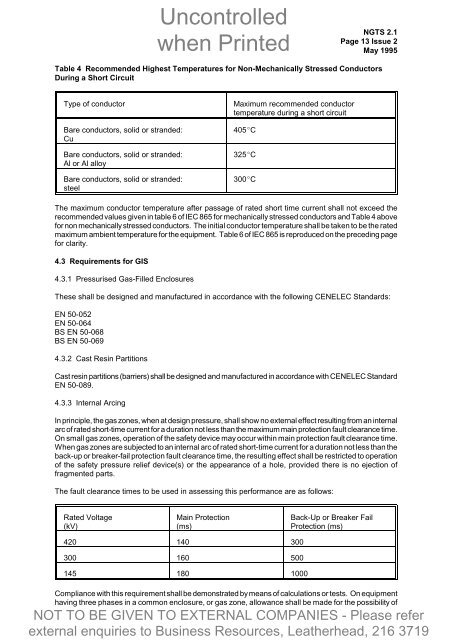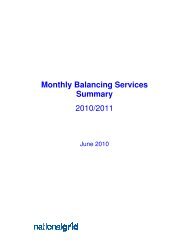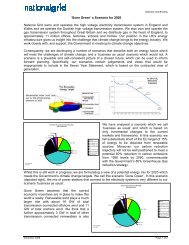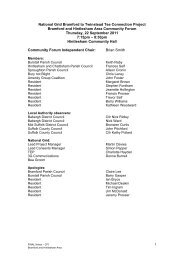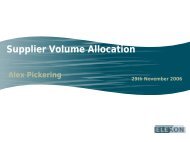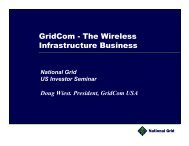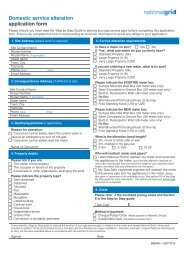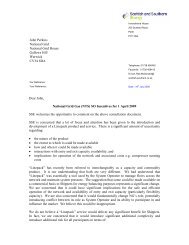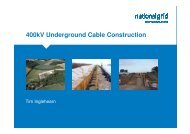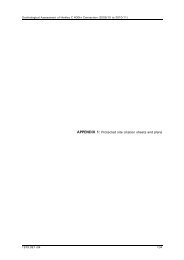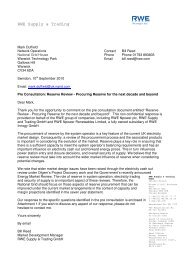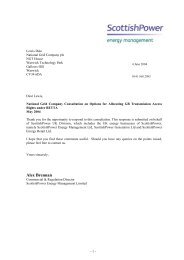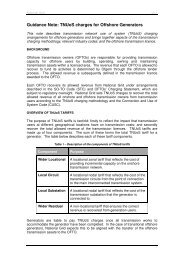Download PDF - National Grid
Download PDF - National Grid
Download PDF - National Grid
Create successful ePaper yourself
Turn your PDF publications into a flip-book with our unique Google optimized e-Paper software.
NGTS 2.1<br />
Page 13 Issue 2<br />
May 1995<br />
Table 4 Recommended Highest Temperatures for Non-Mechanically Stressed Conductors<br />
During a Short Circuit<br />
Type of conductor Maximum recommended conductor<br />
temperature during a short circuit<br />
Bare conductors, solid or stranded:<br />
Cu<br />
Bare conductors, solid or stranded:<br />
Al or Al alloy<br />
Bare conductors, solid or stranded:<br />
steel<br />
405bC<br />
325bC<br />
300bC<br />
The maximum conductor temperature after passage of rated short time current shall not exceed the<br />
recommended values given in table 6 of IEC 865 for mechanically stressed conductors and Table 4 above<br />
for non mechanically stressed conductors. The initial conductor temperature shall be taken to be the rated<br />
maximum ambient temperature for the equipment. Table 6 of IEC 865 is reproduced on the preceding page<br />
for clarity.<br />
4.3 Requirements for GIS<br />
4.3.1 Pressurised Gas-Filled Enclosures<br />
These shall be designed and manufactured in accordance with the following CENELEC Standards:<br />
EN 50-052<br />
EN 50-064<br />
BS EN 50-068<br />
BS EN 50-069<br />
4.3.2 Cast Resin Partitions<br />
Cast resin partitions (barriers) shall be designed and manufactured in accordance with CENELEC Standard<br />
EN 50-089.<br />
4.3.3 Internal Arcing<br />
In principle, the gas zones, when at design pressure, shall show no external effect resulting from an internal<br />
arc of rated short-time current for a duration not less than the maximum main protection fault clearance time.<br />
On small gas zones, operation of the safety device may occur within main protection fault clearance time.<br />
When gas zones are subjected to an internal arc of rated short-time current for a duration not less than the<br />
back-up or breaker-fail protection fault clearance time, the resulting effect shall be restricted to operation<br />
of the safety pressure relief device(s) or the appearance of a hole, provided there is no ejection of<br />
fragmented parts.<br />
The fault clearance times to be used in assessing this performance are as follows:<br />
Rated Voltage<br />
(kV)<br />
Main Protection<br />
(ms)<br />
420 140 300<br />
300 160 500<br />
145 180 1000<br />
Back-Up or Breaker Fail<br />
Protection (ms)<br />
Compliance with this requirement shall be demonstrated by means of calculations or tests. On equipment<br />
having three phases in a common enclosure, or gas zone, allowance shall be made for the possibility of


